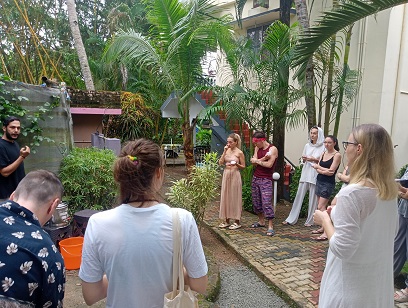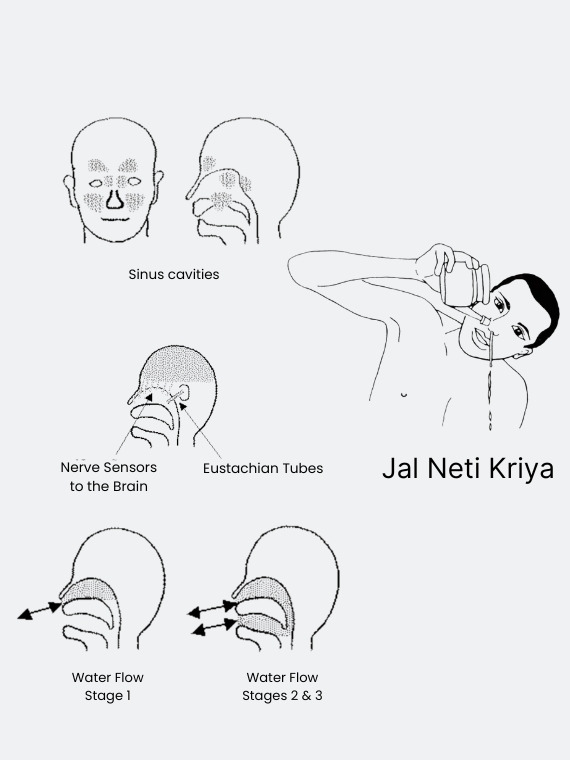What Is Neti Kriya? Types, Benefits, and How to Practice It Safely
Somewhere beneath the gentle rhythm of the ocean and the whisper of a warm tropical breeze, yoga uncovers itself as far more than a physical discipline; it is a sacred science of inner purification and balance. According to the ancient wisdom of yoga, health not only begins with taking care of the outer body but also involves cleansing the internal pathways—the channels through which prana, or life force, flows.
Among the six classical cleansing techniques (shatkarma or shatkriya) of hatha yoga, one practice that shines with simplicity and power is Neti kriya. When your nasal passages are cleared through the practice of neti kriya, the breath flows evenly through both nostrils, preparing you for deeper states of meditation and reaching higher consciousness.

In recent years neti kriya is no longer limited to yoga practitioners and it has become a popular part of modern health and wellness routines, embraced by many people, including well-known celebrities. According to the Indian Express, Indian actor Vidhya Malvade shared that she has been practising Jal neti regularly, about two or three times a week. She revealed this ancient cleansing method to improve her immunity, achieve clearer skin and help her avoid frequent illnesses.

This growing interest in Neti Kriya shows that ancient yogic science continues to offer practical, natural solutions for modern living.
In this blog, we will explore what Neti Kriya actually is, learn about the different types of Neti Kriya, discuss the effects and more, so that all your doubts related to this Kriya will be solved.
What is Neti Kriya?
Neti Kriya is one of the six yogic kriyas in the hatha yoga tradition that focuses on purifying the nasal passages and the upper respiratory tract. When the passageways of your nose are blocked, breathing becomes uneven, which can cause mental restlessness, fatigue or emotional instability. Through the practice of neti kriya, when these passages are cleared, breath flows evenly through both nostrils. Keeping these doorways clean supports our respiratory health, helping us maintain mental clarity, emotional balance and spiritual readiness.

Types of Neti Kriya
Jal neti (nasal cleansing with saline water) is a commonly used practice today. However, the hatha yoga scriptures describe several variations of Neti Kriya. Each form of it serves a unique purpose — whether cleansing, soothing or nourishing the nasal channels.
- Jal Neti Kriya – Jal neti is the most accessible form of neti kriya, which involves pouring lukewarm water into one of the nostrils using a neti pot and allowing it to flow out through the other nostril
- Dugdha Neti (Milk Cleansing) Kriya – Dugdha Neti is a Gentle variation of neti kriya that uses lukewarm milk instead of water. The nourishing quality of milk makes this method ideal for individuals who suffer from dryness, irritation caused by excessive heat or pollution.
- Ghrita Neti (Ghee Cleansing) – Ghrita Neti, also known as ghee cleansing and is an ayurvedic adaptation of neti kriya that uses warm and pure cow ghee. In Ayurveda, ghee is rich in antioxidants. When applied in small amounts to each nostril, it serves as a gentle yet powerful way to lubricate and nourish the nasal membranes.
- Sutra Neti (Thread Cleansing) – Sutra Neti is an advanced variation of Neti kriya and should only be practised under the guidance of an experienced yoga teacher. In this method, a soft rubber catheter or a specially prepared cotton thread is gently inserted through one nostril and brought out through the mouth.

What Are The Benefits of Practising Neti Kriya?
For centuries, yogis have been using neti kriya as an important practice that clears the way for deeper yogic exploration. Neti Kriya is a yogic purification practice that nurtures the body, mind and energy system by enhancing respiratory health, sharpening mental clarity and serving as a bridge between physical well-being and spiritual awakening.
- Helps manage your upper respiratory infections, nasal-related allergies and sinusitis.
- Improves oxygen flow to the brain while boosting concentration and cognitive sharpness.
- Mental freshness and heightened alertness
- Helps activate the parasympathetic nervous system, which lowers stress and anxiety.
- Promotes deeper, more restful sleep.
- Clears the breath and mind, leading to improved mood and emotional well-being
What Will You Need Before Practising Neti kriya?
Before beginning, you must have the right preparation materials. Having everything by your side ensures safety, hygiene and comfort, allowing you to focus on the cleansing process with ease and awareness.
Below are some of the important materials
- Neti pot
- Purified or warmed water
- soft-towel or tissue
- Milk or Ghee (For Advanced Variations)
- A Comfortable and Quiet Space
Preparation Tip
Before performing Neti Kriya, ensure:
- Your stomach is empty or lightly filled (avoid immediately after meals).
- You are free from cold, fever or sinus infection.
- Your mind is calm and you are ready to engage in a gentle, self-cleansing ritual.
How To Perform Neti Kriya Safely?
While the neti kriya practice is easy to learn, it should be approached with patience and mindfulness, especially when you are a complete beginner.
Below is a gentle, step-by-step guide to performing this Kriya correctly and safely, ensuring maximum benefit and comfort.
- Begin by ensuring that your Neti pot or cleansing vessel is dry and clean.
- Use boiled or filtered lukewarm liquid. The temperature should be close to body temperature — comfortably warm, never hot or cold.
- Now stand over a sink or in an open space where the liquid can drain easily. Keep your spine straight and shoulders relaxed.
- Slightly tilt your head at a 45-degree angle, ensuring that one nostril is higher than the other.
- Then gently insert the tip of the neti pot into your upper nostril, the one facing upward.
- Keep your mouth open and breathe calmly through it as you let the liquid flow naturally from one nostril to the other.
- The intention here is to let gravity do the work naturally.
- Once half of the solution has passed through, return to the neutral position, rest and breathe normally for a few seconds.
- Now tilt your head to the opposite side and repeat the same process for the other nostril.
- After the cleansing is complete, take a moment to clear out any remaining liquid.
You can perform a few rounds of gentle breathing or pranayama, such as Kapalabhati or Anulom Vilom, to balance the nasal passages.
Also Read: Unlock Your Inner Calm: The Power of Anulom Vilom Pranayama in Modern Living

When Should You Avoid Practising Neti Kriya
Although for most people, this kriya is safe, following certain precautions is necessary, which ensures a comfortable experience for everyone-
- If you have active nasal bleeding, ear infections, or have recently undergone nasal surgery, avoid the practice.
- Always remember to use boiled or filtered water cooled to body temperature to prevent infections.
- If you experience pain, dizziness or prolonged discomfort, stop immediately and consult your teacher or a qualified yoga therapist.
Conclusion
In the rush of the modern world, where stress, pollution and an irregular lifestyle disturb your inner balance, Neti Kriya guides you back to a state of clarity and natural ease. Although practising neti kriya is a simple physical technique, it plays a significant role in yogic tradition because it is not only about cleansing your nasal passages, but also about how the breath moves freely, the mind settles and your senses sharpen. This is why most yogis have always considered neti kriya a spiritual doorway to deeper layers of awareness.
If you are a beginner and wish to learn this kriya with proper guidance, consider joining Rishikul Yogshala in Kerala. Whether you enrol in the 200 hour yoga teacher training or the 300-hour yoga teacher training course, our experienced teachers provide step-by-step instruction, helping you practice Neti Kriya safely and with the proper technique.
Frequently Asked Questions
Q1. Is neti kriya safe for beginners?
Ans: When practised correctly, neti kriya is generally safe for beginners. However, learning from a trained yoga teacher ensures the proper technique, the correct water temperature and the correct breathing pattern.
Q2. Can neti kriya help treat allergies, sinusitis or nasal congestion?
Yes, including neti kriya in your life can be a game-changer, as it helps remove mucus, dust and allergens from the nasal passages.
Q3. What type of water should I use for jal neti practice?
Always use filtered water that has been cooled to lukewarm — neither too hot nor too cold — to avoid irritation around your nose.
Q4. How often should I practice Neti Kriya?
Ans: For most people, practising Jal Neti 2–3 times per week is sufficient to maintain clear breathing and nasal hygiene. Daily practice may be done under guidance, especially if you are dealing with sinus issues.
Q5. Can I practice Neti Kriya if I have a cold or sinus infection?
Ans: It’s not recommended to perform Neti Kriya if you have an active sinus infection, severe cold, nasal bleeding, or blocked nasal passages, as it may cause discomfort or irritation. Wait until symptoms reduce.
Q6. Does Neti Kriya help with snoring or sleep issues?
Ans: Yes, Neti Kriya can help reduce snoring for some people by clearing nasal blockages and allowing smoother airflow. This often leads to more restful, deeper sleep.
Q7. Can children practice Neti Kriya?
Ans: Children can practice very gentle forms of Jal Neti, but only under the supervision of a trained teacher or parent who is experienced with the technique. Never force the practice.
Q8. What should I do after performing Neti Kriya?
Ans: After the cleansing, gently exhale to remove excess water and practice a few rounds of Kapalabhati or Anulom Vilom to fully dry the nasal passages and balance breath flow.

MEDITATION, INSPIRATIONAL AND SPIRITUAL GUIDE
Yogi Gangesha Chaitanya is a master of Yoga Philosophy, Meditation, Pranayama, and Spiritual Guidance, trained under Swami Rama and renowned institutions like the Himalayan Tradition and Sri Aurobindo Ashram. With expertise in Kundalini Yoga and meditation, he mentors students in 200-hour and 300-hour Yoga Teacher Training programs, guiding them toward inner awareness, spiritual growth, and a deeper understanding of yoga.
View Instagram Profile













